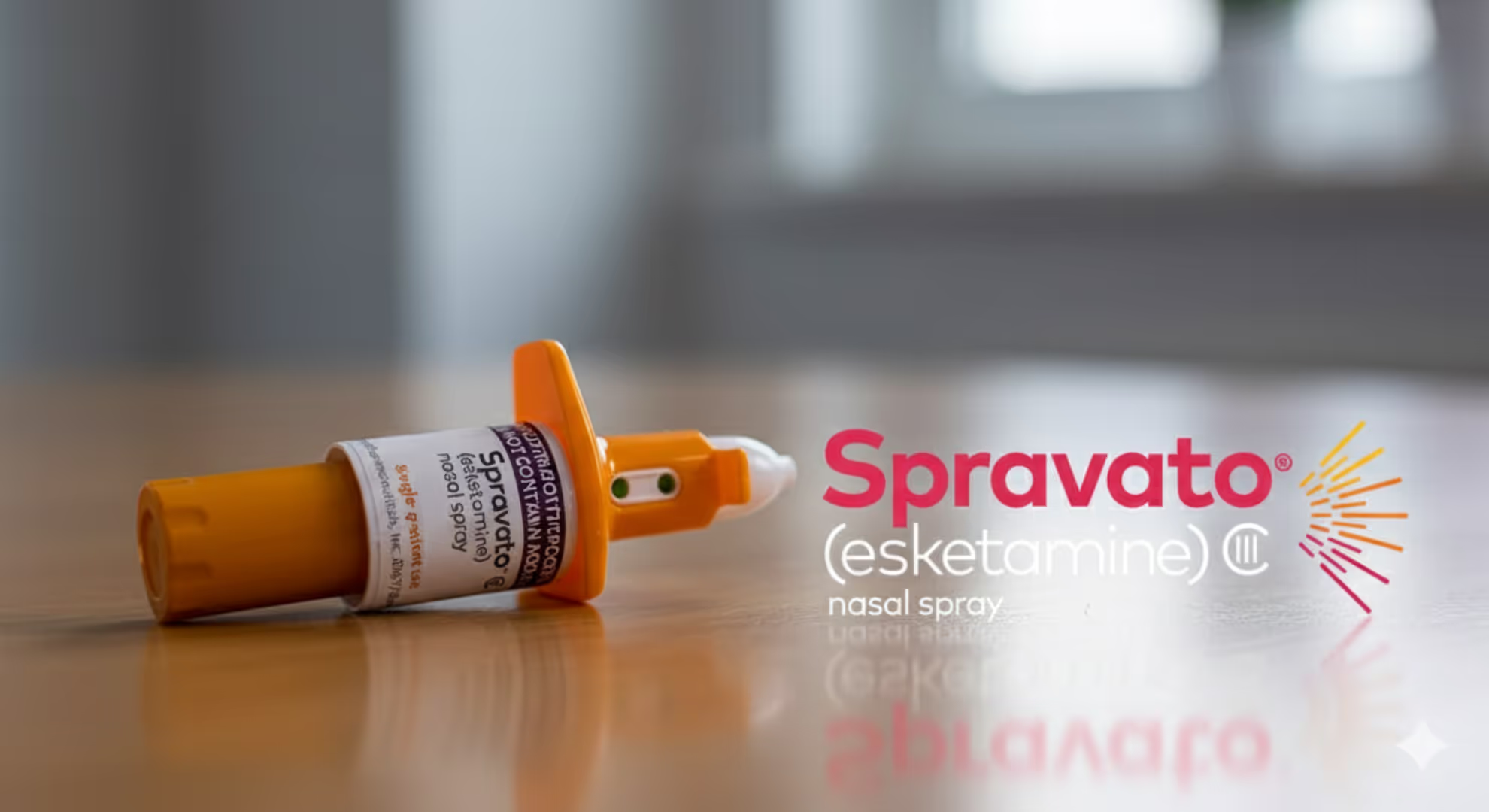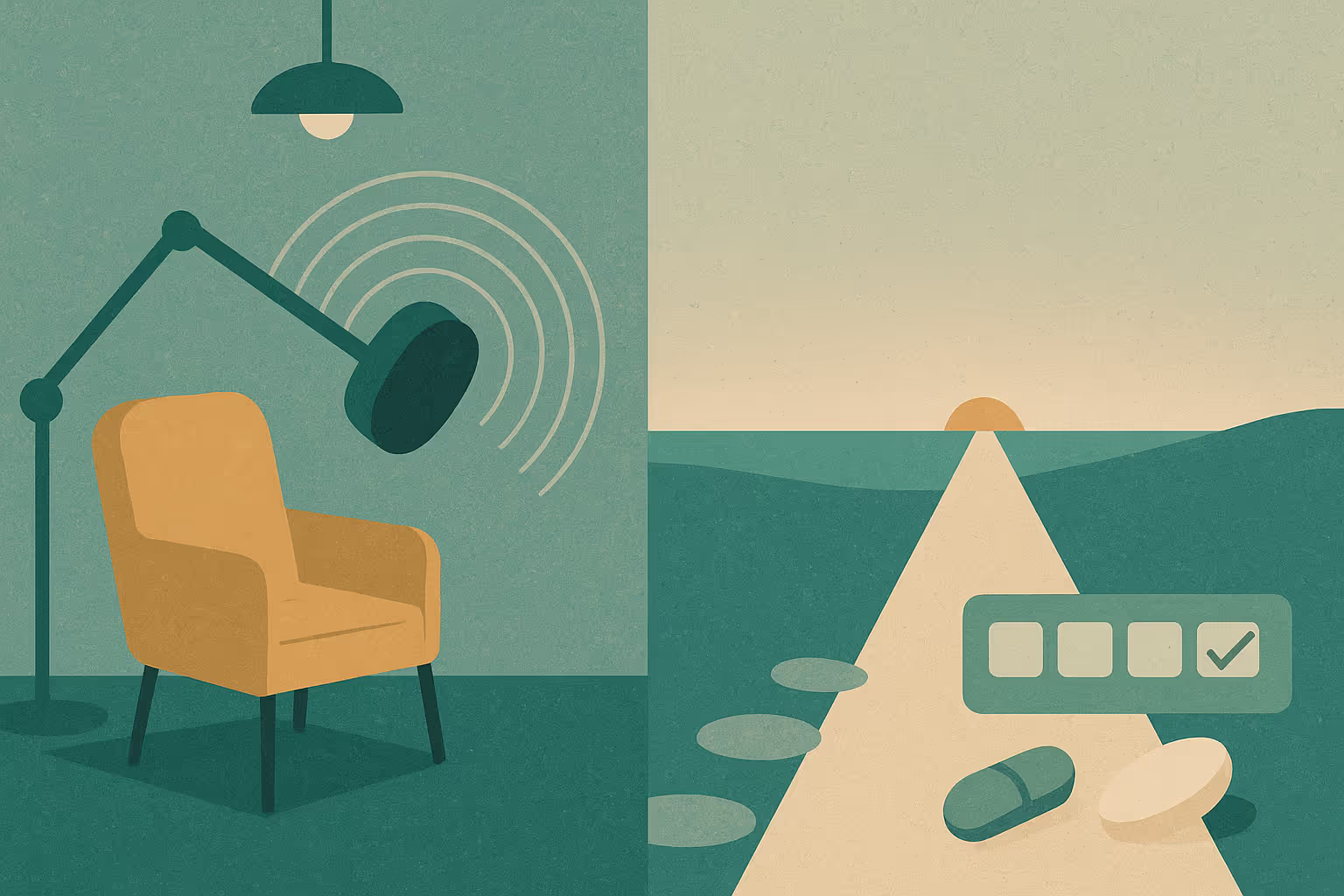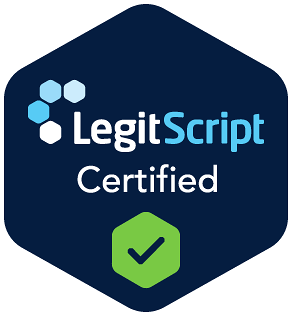When patients and providers reach that familiar crossroads — after multiple medication trials, therapy sessions that feel paused, and still the sense that something isn’t shifting — it’s natural to ask, what else can help? For some, that “something else” is esketamine (Spravato).
At Lumin Health, we understand that for many clinicians, Spravato remains both promising and opaque: FDA-approved, covered by insurance, yet surrounded by misconceptions. This primer was written for you — the psychiatrist, therapist, primary care clinician, EAP lead, or other care provider — who wants to understand how it actually works in real-world care.
Spravato is a structured, evidence-based treatment that runs on partnership. Esketamine (Spravato) has been FDA approved since 2019, it has efficacy that outperforms antidepressant medications (irrespective of the number of antidepressant trials previously attempted) and works more quickly than standard antidepressant medications. Our goal at Lumin Health is to make the logistics, safety, and coordination of Spravato treatment transparent — so you can guide your patients with clarity and confidence.
Indications, Dosing, and Monitoring of Esketamine (Spravato)
Spravato FDA label basics
Esketamine (Spravato) is the first FDA-approved nasal ketamine formulation indicated for:
- Treatment-resistant depression (TRD) in adults who have not responded adequately to at least two-four different antidepressant trials.
- Major depressive disorder (MDD) with suicidal ideation or behavior.
It’s important to emphasize that esketamine (Spravato) treatment is never a take-home medication. It is administered exclusively in REMS-certified medical settings, under direct supervision from trained clinicians.
Each session at Lumin Health includes pre-dose assessment, in-clinic observation, and post-dose recovery before the patient is cleared to leave.
Esketamine (Spravato) Dosing schedules
Spravato’s structure gives both predictability and flexibility.
- Induction phase (Weeks 1–4): Twice-weekly doses at 56 mg or 84 mg, determined after the first session based on tolerability and clinical effect.
- Optimization phase (Weeks 5–8): Once weekly as symptoms stabilize.
- Maintenance (Week 9+): Every 1–2 weeks depending on patient response, clinical judgment, and insurance criteria. The treatment frequency is titrated to a patient’s need with some dosing frequency extending to every 4+ weeks.
The predictable cadence is one reason clinicians like partnering with a Spravato clinic — you know when your patient is being seen, and we know when to send you updates.
“It’s less a mysterious process,” Dr. Ben Yudkoff shared recently, “and more a structured rhythm of care — steady, collaborative, accountable”.
On-site observation during Esketamine (Spravato) treatment
Each Spravato session lasts about two hours:
- Pre-dose: vitals, mental-status check, brief conversation about the patient’s mood and medications.
- Administration: the patient self-administers the nasal spray under clinician supervision.
- Observation: continuous monitoring of blood pressure, O2 saturation, and subjective experience.
- Recovery: patients remain in private rooms until vitals and cognition normalize. They must arrange a ride home — no driving the day of treatment.
Every session includes the same Lumin Health team members for continuity and comfort; familiarity itself is part of the safety net.
Common effects & side effects of Spravato (Esketamine)
Most patients experience transient effects lasting 30 – 90 minutes:
- Mild dissociation or “detachment” — described by many as dreamlike or slowed perception.
- Transient increases in blood pressure or heart rate, monitored closely and typically resolving before discharge.
- Fatigue or nausea, occasionally treated with supportive medication.
These effects are expected and part of the supervised experience. Patients are never left unsupervised and they are guided through grounding and recovery protocols during and after esketamine dosing.
In rare cases, emotional discomfort or resurfacing of memories may arise. Our clinicians are trained to support these moments with presence and compassion — not suppression.
Insurance, Access, and Collaboration for Esketamine (Spravato)
One of the most practical benefits of Spravato treatment is accessibility: it’s covered by most major insurance plans, including Medicare, when criteria for TRD or MDD with suicidality are met.
Lumin Health manages all prior authorizations, REMS documentation, and insurer communication. Referring providers remain informed but never buried in paperwork.
Referrers receive:
- Notification after evaluation confirming eligibility and safety.
- Summaries after key milestones (first dose, midpoint, and completion of induction).
- Rapid contact if medical or psychiatric concerns arise.
Our process ensures your patient’s care unfolds under your umbrella, not outside it.
“The outpatient provider stays at the helm,” Dr. Yudkoff emphasized in our provider workshop. “We see ourselves in a consultative role, much like a physical therapist might be for an orthopedic team — specialized, but always in support of the broader treatment plan.”
When to Consider Spravato for your Patient
You might consider referring to a Spravato clinic like Lumin Health when:
- Two or more adequate antidepressant trials have failed.
- The patient’s depression is severe or accompanied by suicidal ideation.
- The patient cannot tolerate further dose adjustments of standard medications.
- There is a need for faster symptom relief to restore functionality and safety.
Every case begins with a no-cost medical necessity evaluation to confirm candidacy.
What to Tell Patients who Are Interested in Esketamine (Spravato)
When your patient asks, “What will it be like?” — you can offer this simple, grounded description:
“Spravato is a supervised, in-clinic treatment. You’ll come in, take the medicine through a nasal spray, and rest in a quiet private room for about two hours while we monitor you. Most people feel calm or a bit dreamlike for a short time. Some start to feel relief within days, while for others, it builds gradually. You’ll keep seeing me, and Lumin Health will share updates so we stay connected.”
That framing gives both reassurance and continuity — the two ingredients that make hope feel safe.
Heading 1
Heading 2
Heading 3
Heading 4
Heading 5
Heading 6
Lorem ipsum dolor sit amet, consectetur adipiscing elit, sed do eiusmod tempor incididunt ut labore et dolore magna aliqua. Ut enim ad minim veniam, quis nostrud exercitation ullamco laboris nisi ut aliquip ex ea commodo consequat. Duis aute irure dolor in reprehenderit in voluptate velit esse cillum dolore eu fugiat nulla pariatur.
Block quote
Ordered list
- Item 1
- Item 2
- Item 3
Unordered list
- Item A
- Item B
- Item C
Bold text
Emphasis
Superscript
Subscript







